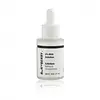What's inside
What's inside
 Key Ingredients
Key Ingredients

 Benefits
Benefits

 Concerns
Concerns

 Ingredients Side-by-side
Ingredients Side-by-side

Water
Skin ConditioningMethylpropanediol
SolventButylene Glycol
HumectantEthoxydiglycol
HumectantDimethyl Isosorbide
SolventSalicylic Acid
MaskingGlycerin
HumectantMarrubium Vulgare Extract
Skin ConditioningPentylene Glycol
Skin ConditioningPolylysine
Sodium Hyaluronate
HumectantEpigallocatechin Gallatyl Glucoside
AntioxidantHydroxyethylcellulose
Emulsion StabilisingXanthan Gum
EmulsifyingLecithin
EmollientSclerotium Gum
Emulsion StabilisingPullulan
Phenoxyethanol
PreservativeLactic Acid
BufferingIsoceteth-20
EmulsifyingTrisodium Ethylenediamine Disuccinate
Ethylhexylglycerin
Skin ConditioningOligopeptide-10
AntimicrobialSodium Hydroxide
BufferingWater, Methylpropanediol, Butylene Glycol, Ethoxydiglycol, Dimethyl Isosorbide, Salicylic Acid, Glycerin, Marrubium Vulgare Extract, Pentylene Glycol, Polylysine, Sodium Hyaluronate, Epigallocatechin Gallatyl Glucoside, Hydroxyethylcellulose, Xanthan Gum, Lecithin, Sclerotium Gum, Pullulan, Phenoxyethanol, Lactic Acid, Isoceteth-20, Trisodium Ethylenediamine Disuccinate, Ethylhexylglycerin, Oligopeptide-10, Sodium Hydroxide
Water
Skin ConditioningGlycerin
HumectantHydrolyzed Soy Protein
HumectantSalicylic Acid
MaskingTriethanolamine
BufferingXylitylglucoside
HumectantAnhydroxylitol
HumectantXanthan Gum
EmulsifyingBetaine
HumectantXylitol
HumectantBeta-Glucan
Skin ConditioningAllantoin
Skin ConditioningBiosaccharide Gum-1
HumectantCaprylyl Glycol
EmollientEthylhexylglycerin
Skin ConditioningGlucose
HumectantChondrus Crispus Extract
Skin ConditioningPhenoxyethanol
PreservativeChlorphenesin
Antimicrobial
 Reviews
Reviews

Ingredients Explained
These ingredients are found in both products.
Ingredients higher up in an ingredient list are typically present in a larger amount.
Ethylhexylglycerin (we can't pronounce this either) is commonly used as a preservative and skin softener. It is derived from glyceryl.
You might see Ethylhexylglycerin often paired with other preservatives such as phenoxyethanol. Ethylhexylglycerin has been found to increase the effectiveness of these other preservatives.
Glycerin is already naturally found in your skin. It helps moisturize and protect your skin.
A study from 2016 found glycerin to be more effective as a humectant than AHAs and hyaluronic acid.
As a humectant, it helps the skin stay hydrated by pulling moisture to your skin. The low molecular weight of glycerin allows it to pull moisture into the deeper layers of your skin.
Hydrated skin improves your skin barrier; Your skin barrier helps protect against irritants and bacteria.
Glycerin has also been found to have antimicrobial and antiviral properties. Due to these properties, glycerin is often used in wound and burn treatments.
In cosmetics, glycerin is usually derived from plants such as soybean or palm. However, it can also be sourced from animals, such as tallow or animal fat.
This ingredient is organic, colorless, odorless, and non-toxic.
Glycerin is the name for this ingredient in American English. British English uses Glycerol/Glycerine.
Learn more about GlycerinPhenoxyethanol is a preservative that has germicide, antimicrobial, and aromatic properties. Studies show that phenoxyethanol can prevent microbial growth. By itself, it has a scent that is similar to that of a rose.
It's often used in formulations along with Caprylyl Glycol to preserve the shelf life of products.
Salicylic Acid (also known as beta hydroxy acid or BHA) is a well-known ingredient for treating skin that struggles with acne and clogged pores. It exfoliates both the skin's surface and deep within the pores to help clear out buildup, control oil, and reduce inflammation.
Unlike AHAs (alpha hydroxy acids), salicylic acid is oil-soluble. This allows it to penetrate into pores which makes it especially effective for treating blackheads and preventing future breakouts.
Salicylic acid is also known for its soothing properties. It has a similar structure to aspirin and can calm inflamed or irritated skin, making it a good option for acne-prone skin that is also sensitive.
Concentrations of 0.5-2% are recognized by the U.S. FDA as an over-the-counter topical acne product.
It can cause irritation and/or dryness if one's skin already has a compromised moisture barrier, so it's best to focus on repairing that before introducing this ingredient into your routine.
While salicylic acid does not increase sun sensitivity, it’s still important to wear sunscreen daily to protect your skin.
If you are looking for the ingredient called BHA or Butylated Hydroxyanisole, click here.
Learn more about Salicylic AcidWater. It's the most common cosmetic ingredient of all. You'll usually see it at the top of ingredient lists, meaning that it makes up the largest part of the product.
So why is it so popular? Water most often acts as a solvent - this means that it helps dissolve other ingredients into the formulation.
You'll also recognize water as that liquid we all need to stay alive. If you see this, drink a glass of water. Stay hydrated!
Learn more about WaterXanthan gum is used as a stabilizer and thickener within cosmetic products. It helps give products a sticky, thick feeling - preventing them from being too runny.
On the technical side of things, xanthan gum is a polysaccharide - a combination consisting of multiple sugar molecules bonded together.
Xanthan gum is a pretty common and great ingredient. It is a natural, non-toxic, non-irritating ingredient that is also commonly used in food products.
Learn more about Xanthan Gum